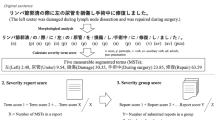Abstract
Voluntary medical incident reporting systems are a valuable source for studying adverse events and near misses. Unfortunately, such systems usually contain a large amount of incomplete and inaccurate reports which negatively affect their utility for medical error research. To investigate the reporting quality and propose solutions towards quality voluntary reports, we employed a content analysis method to examine one-year voluntary medical incident reports of a University Hospital. Results indicate that there is a large amount of inconsistent records within the reports. About 25% of the reports were labeled as “miscellaneous” and “other”. Through an in-depth analysis, those “miscellaneous” and “other” were substituted by their real incident types or error descriptions. Analysis shows that the pre-defined reporting categories serve well in general for the voluntary reporting need. In some cases, human factors play a key role in selecting accurate categories since reporters lack time or information to complete the report. We suggest that a human-centered, ontology based system design for voluntary reporting is feasible. Such a design could help improve the completeness and accuracy, and interoperability among national and international standards.

Similar content being viewed by others
References
Murff, H. J., Patel, V. L., Hripcsak, G., and Bates, D. W., Detecting adverse events for patient safety research: a review of current methodologies. J. Biomed. Inf. 36(1–2):131–43, 2003.
Kim, J., and Bates, D. W., Results of a survey on medical error reporting systems in Korean hospitals. Int. J. Med. Inf. 75(2):148–155, 2006.
Barach, P., and Small, S. D., Reporting and preventing medical mishaps: lessons from non-medical near miss reporting systems. Br. Med. J. 320:759–763, 2000.
Milch, C. E., Salem, D. N., Pauker, S. G., Lundquist, T. G., Kumar, S., and Chen, J. Voluntary electronic reporting of medical errors and adverse events. An analysis of 92,547 reports from 26 acute care hospitals. J. Gen. Intern. Med. 21(2):165–170, 2006.
Johnson, C., A handbook of accident and incident reporting. Glasgow, Glasgow University Press, 2003.
Harris, C. B., Krauss, M. J., Coopersmith, C. M., Avidan, M., Nast, P. A., Kollef, M. H., et al., Patient safety event reporting in critical care: a study of three intensive care units. Crit. Care Med. 35(4):1068–1076, 2007.
Carayon, P., Handbook of human factors and ergonomics in health care and patient safety. Mahwah, N.J., Lawrence Erlbaum Associates, 2007.
Tamuz, M., and Harrison, M. I., Improving patient safety in hospitals: contributions of high-reliability theory and normal accident theory. Health Serv. Res. 41(4 Pt 2):1654–1676, 2006.
Tamuz, M., Thomas, E. J., and Franchois, K. E., Defining and classifying medical error: lessons for patient safety reporting systems. Qual. Saf. Health Care. 13(1):13–20, 2004.
Gong, Y., Richardson, J., Luan, Z., Alafaireet, P., and Yoo, I. Analyzing voluntary medical incident reports. AMIA Annu Symp Proc. 2008 Nov. 6:955.
AHRQ. Users guide AHRQ Common Formats for patient safety organizations: Agency for healthcare Research and Quality, 2008.
WHO. The conceptual framework for the international classification for patient safety: World Health Organization, 2007.
Unknown. PSN Report Policy. Columbia: University of Missouri Health Care; 2006 [cited 2008]; Available from: https://apps.muhealth.org/psn/psn_learning/policy.html.
Fischer, M. A., Mazor, K. M., Baril, J., Alper, E., DeMarco, D., and Pugnaire, M., Learning from mistakes. Factors that influence how students and residents learn from medical errors. J. Gen. Int. Med. 21(5):419–423, 2006.
Zhan, C., Smith, S. R., Keyes, M. A., Hicks, R. W., Cousins, D. D., and Clancy, C. M., How useful are voluntary medication error reports? The case of Warfarin-related medication errors. Joint Commission Journal on Quality and Patient Safety. 34:36–45, 2008.
Morse, J. M., Preventing patient falls: establishing a fall intervention program, 2nd edition. Springer, New York, 2009.
Acknowledgements
This project is supported in part by a grant (URC-08-023) awarded by the Research Council of University of Missouri-Columbia, by Richard Wallace Research Incentive Grant Award, and by the Center for Health Care Quality of University of Missouri Health Care. The author expresses heartfelt thanks to Zhijian Luan, James Richardson, Patricia Alafaireet and Illhoi Yoo who assisted in de-identifying and analyzing data in early stages. A special thank goes to two anonymous reviewers who offered invaluable constructive comments for an early draft.
Author information
Authors and Affiliations
Corresponding author
Rights and permissions
About this article
Cite this article
Gong, Y. Data Consistency in a Voluntary Medical Incident Reporting System. J Med Syst 35, 609–615 (2011). https://doi.org/10.1007/s10916-009-9398-y
Received:
Accepted:
Published:
Issue Date:
DOI: https://doi.org/10.1007/s10916-009-9398-y




